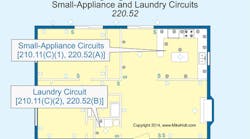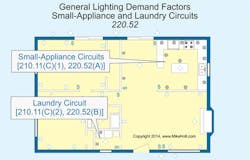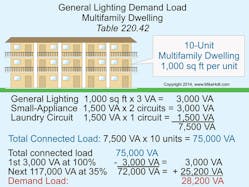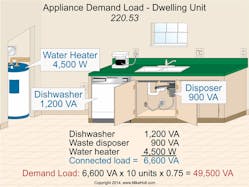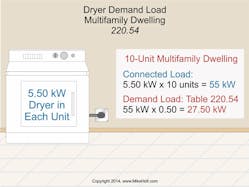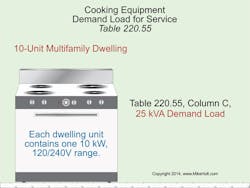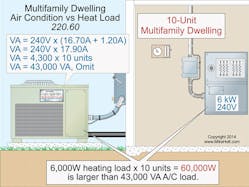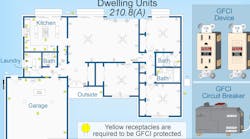A multifamily dwelling is one that contains three or more dwelling units [Art. 100]. Though similar, single and multifamily dwellings have distinct differences.
The wiring method used for a single-family dwelling unit is often Type NM cable (unless local codes don’t allow it). Depending on factors such as the building construction type and local codes, a multifamily dwelling may require the use of metal raceways or metallic-sheathed cable [334.10, Annex D].
When sizing the 120/240V single-phase service or feeder conductors for a single-family dwelling, you can use Sec. 310.15(B)(7). To size conductors for the service or feeder for a multifamily dwelling, you must use Table 310.15(B)(16). You can use Sec. 310.15(B)(7) for the feeders to an individual dwelling unit within the multifamily building if supplied by a 120/240V single-phase system.
For individual dwelling units, you don’t add up the individual loads to size the service. Instead, you must size the main service of a multifamily dwelling based on the sum of all of the individual dwelling unit loads (with the appropriate demand factors applied).
Related
Standard method [Art. 220, Part III]
For multifamily dwellings, the standard method for determining the feeder or service size is the same as for single-family dwelling units; however, the demand factors are different. Here are the steps:
Step 1: General Lighting and General-Use Receptacles, Small-Appliance, and Laundry Circuits [Table 220.42]
The NEC recognizes that the general lighting and receptacle, small-appliance, and laundry circuits won’t all be running at full load at the same time. It allows you to apply a demand factor to the total connected load [220.52] (Fig. 1 ). To determine the service/feeder demand load for these circuits, use these substeps:
First, determine the total connected load of all dwelling units for:
- General lighting and receptacles at 3VA per sq ft [220.12],
- Two small-appliance circuits each at 1,500VA [220.52(A)], and
- One laundry circuit at 1,500VA [220.52(B)].
Note that you don’t need a laundry circuit for individual dwelling units, if common laundry facilities are provided [210.52(F), Exception No. 1].
Next, apply the Table 220.42 demand factors to the total connected load. (First 3,000VA at 100% demand; the next 117,000VA (3,001VA through 120,000VA) at 35% demand; any remaining VA at 25% demand) (Fig. 2).
Step 2: Appliances [220.53]
You can apply a 75% demand factor when four or more appliances are fastened in place. This doesn’t apply to space-heating equipment [220.51], clothes dryers [220.54], cooking appliances [220.55], or air-conditioning equipment.
When calculating the demand factor for the appliance load for a multifamily dwelling (as described in Sec. 220.53), include all of the appliances in all dwelling units as part of the main service calculation. There will invariably be more than 4 appliances on the main service. For example, if there are three appliances per unit and there are 10 units, then three appliances × 10 units = 30 total appliances on the service. A 75% demand factor could be applied to connected load of those 30 appliances (Fig. 3).
Step 3: Clothes Dryers [220.54]
The feeder or service demand load for household electric clothes dryers in dwelling units must be at least 5,000W or the nameplate rating (whichever is greater). You can adjust this per the demand factors in Table 220.54. You can’t use this method to calculate the loads of dryers in common laundry rooms. A dryer load isn’t required if the dwelling unit doesn’t contain an electric dryer (Fig. 4).
Step 4: Cooking Equipment [220.55]
Household cooking appliances rated greater than 1¾ kW can have the feeder and service calculated per the demand factors of Table 220.55, including Notes 1, 2, and 3 (Fig. 5).
Step 5: Air-Conditioning versus Heat
Because the air-conditioning and heating loads don’t run simultaneously, you can omit the smaller of the two [220.60]. Calculate these at 100% [220.50, 220.51] (Fig. 6).
Step 6: Feeder and Service Conductor Size
The feeder/service conductor size is determined by adding all the connected loads of Steps 1-5 after any applicable demand factors have been applied, then use Table 310.15(B)(16) to select the conductor size. Conductors are presumed to be copper unless otherwise stated [110.5]; systems are presumed to be single-phase unless otherwise stated.
If there are house loads, such as hall and parking lot lighting, common laundry facilities, lobby circuits, sprinkler pumps, etc., use Art. 220, Part III to calculate these separately and add them to Step 6 total before selecting the feeder/service conductors.
Optional method
Part IV of Art. 220 provides optional calculation methods. Use Sec. 220.84 for three or more dwelling units of a multifamily dwelling. This method lets you apply demand factors in recognition of the diversity of usage of all the loads in all the separate units. You use the demand factors of Table 220.84, based on the number of dwelling units [220.84(A)(1), (2), and (3)]. But you determine the feeder/service neutral demand load per Sec. 220.61.
You can apply the optional method only if:
- It’s a multifamily building consisting of three or more dwelling units, and
- Each dwelling unit is supplied by no more than one feeder and equipped with electric cooking equipment.
- The feeder is for a dwelling unit equipped with electric heating and/or air-conditioning.
House loads are those not directly associated with the individual dwelling units of a multifamily dwelling. Examples include landscape and parking lot lighting, hall and stairway lighting, common laundry facilities, and common pool and recreation areas. Calculate these loads per Art. 220, Part III and then add them to the Table 220.84 demand load.
Follow these steps to determine feeder and service sizes for a multifamily dwelling using the optional method contained in Art. 220, Part IV:
Step 1: Total Connected Load [220.84(C)]
Add up the following connected loads from all the dwelling units, and then apply the Table 220.84 demand factor to determine the demand load:
- 3VA per sq ft for general lighting and general-use receptacles.
- 1,500VA for each small-appliance circuit (minimum of 2 circuits).
- 1,500VA for each laundry circuit.
- The nameplate rating of all appliances (include cooking equipment and clothes dryers).
- The nameplate rating of all motors.
- The larger of the air-conditioning load or the space-heating load.
Note that you don’t need a laundry circuit for individual dwelling units if common laundry facilities are provided [210.52(F), Exception No. 1].
Step 2: Demand Load
Determine the demand load by applying the demand factor from Table 220.84 to the total connected load (Step 1).
Step 3: Service and Service Conductor Size
Size the ungrounded conductors per Table 310.15(B)(16), based on the demand load.
Here are a few other considerations to keep in mind:
- If (when using the standard calculation method under Part III of Art. 220) the demand load for two dwelling units supplied by a single feeder exceeds that for three identical units calculated under the optional method of Sec. 220.84, you can use the lesser of the two loads [220.85].
- Calculate the neutral demand load for household cooking appliances (e.g., electric ranges, wall-mounted ovens, or counter-mounted cooking units) at 70% of the demand load as determined by Sec. 220.55 [220.61(B)(1)].
- The neutral load is the maximum unbalanced calculated load between the neutral conductor and any ungrounded conductor as determined by Art. 220, Part III, and as adjusted per Sec. 220.61(B).
- You can apply a demand factor of 70% to that portion of the unbalanced load exceeding 200A [220.61(B)(2)]
Similar, but not identical
The process of sizing branch circuits, feeders, and service conductors for multifamily dwellings is similar to the process for single-family dwellings. You size the feeders to individual dwelling units the same way — whether that dwelling unit is a single-family dwelling or an individual unit of an apartment building.
The NEC allows the use of Sec. 310.15(B)(7) for sizing 120/240V single-phase feeders or service conductors to an individual dwelling unit; however, the conductors that feed the service to a multifamily dwelling must be sized using Table 310.15(B)(16).
Some additional demand factors for multifamily dwellings are allowed on the presumption there will be diversity of usage between the various units. Dryers are allowed the demand factors of Table 220.54 (standard method), but these don’t provide less than 100% demand until there are five units or more.
Perhaps the most confusing table in the NEC is Table 220.55 for household ranges. People taking their journeyman or master electrician exam often get tripped up on this table. It’s confusing because the first two columns are percentage multipliers, while the third column is a final kVA value. The notes to this table are fairly dense and further complicate matters. If you must use this table, pay attention to that column issue and read the notes carefully.
Holt is the owner of Mike Holt Enterprises, Inc. in Leesburg, Fla. He can be reached at www.mikeholt.com.
